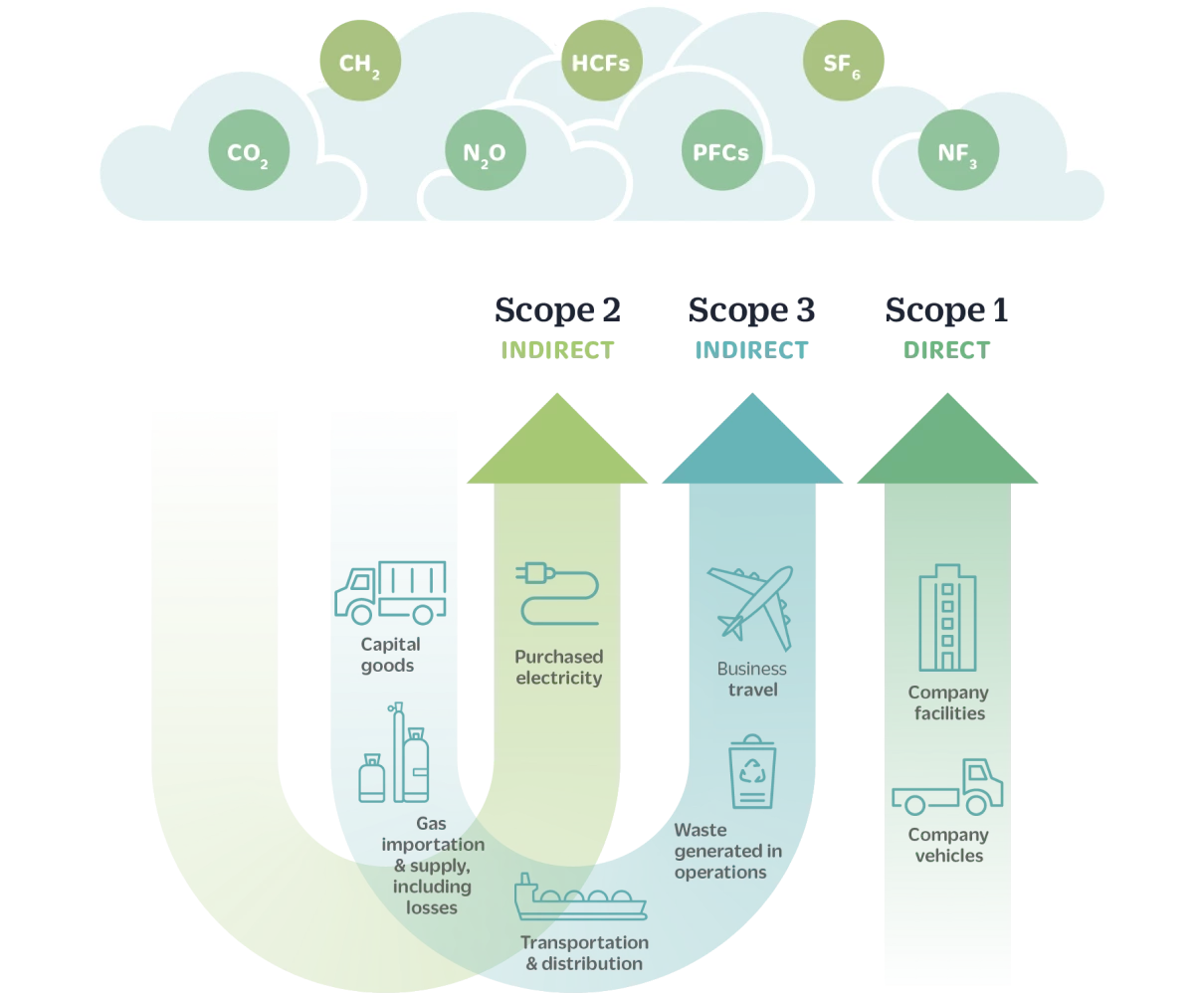Our approach to Carbon Reporting
Policymakers on all islands have agreed Net Zero aspirations, but most of the detailed action plans for delivery are not yet figured out. The decisions that Governments make will significantly influence how this Sustainability Strategy evolves but we’re not waiting to get started. We know that collaboration, data sharing and partnerships are key for a successful energy transition, so we’re going to be working even more closely with Governments, the island’s energy forums, other energy providers and green energy innovators to cement the relationships that will drive change. The key policy headlines in each of our island jurisdictions are as follows:

Defining our scope
and boundaries
A widely-accepted approach for GHG reporting is to identify and categorise emissions-releasing activities is the use of scopes. These are defined in the GHG Protocol Corporate Standard and are described below
Scope 1
Direct emissions
Emissions from activities owned or controlled by your organisation that release emissions into the atmosphere. They are direct emissions. Examples of scope 1 emissions include emissions from combustion in owned or controlled boilers, furnaces, vehicles; emissions from chemical production in owned or controlled process equipment.
Scope 2
Energy indirect emissions
Emissions released into the atmosphere associated with your consumption of purchased electricity, heat, steam and cooling. These are indirect emissions that are a consequence of your organisation’s activities but which occur at sources you do not own or control.
Scope 3
Other indirect emissions
Emissions that are a consequence of your actions, which occur at sources which you do not own or control and which are not classed as scope 2 emissions. Examples of scope 3 emissions are business travel by means not owned or controlled by your organisation, waste disposal which is not owned or controlled, or purchased materials or fuels
The IEG reporting methodology follows the Greenhouse Gas Protocol Reporting Standard Revised Edition. The emission factors used are sourced from the Greenhouse Gas Conversion Factor Repository

Align with science based targets
Through the 2015 Paris Agreement, world governments committed to curbing global temperature rise to well-below 2°C above pre-industrial levels and pursuing efforts to limit warming to 1.5°C. Companies that set carbon reduction targets underpinned by a defined methodology to measure and reduce carbon emissions to limit global temperature rise by a set °C are said to have a ‘science-based target’.
The international organisation which developed the standard for Net Zero (Science Based Targets Initiative (SBTi) are in the process of developing guidance for the Oil & Gas sector. In the interim, IEG has committed to be proactive and align our methodology and target setting with the requirements of the SBTi standard, as follows: Scope of the Net Zero targets shall include the whole organisation (Scope 1 - 3) We shall develop a Net Zero Action Plan to reduce emissions that demonstrates continual improvement IEG shall only use removal offsets (and no longer purchase avoidance offsets) Any offsets IEG use to offset our carbon shall be good quality - I.e. Gold Standard
Net Zero Action Plan
Carbon reduction targets and a glide path to net zero by 2050
IEG has recognised the need for energy companies to evolve to meet the needs of the energy transition and path to Net Zero by 2050. As an energy company, we need to go above and beyond in the standards we set for ourselves, hence our commitment in our North Stars to 'Role Model Net Zero’. Becoming a Net Zero business is a journey, and we are at the start of that journey. The output of our carbon reporting has been used to set our Net Zero action planning detailing how we will reduce our scope 1-3 emissions and science-based targets for the business. We have developed an outline roadmap of actions, which we shall keep reviewing to identify new and improved ways to support, innovate, understand and influence government policy and evaluate how each might impact our strategic plan and our progress towards our targets.


Carbon offsetting

To align with the SBTi standard we are developing a Net Zero Action Plan to reduce emissions that demonstrates continual improvement and only use good quality (i.e Gold Standard) removal offsets for what we cannot avoid, remove, or reduce.
Rather than offsetting all of our emissions and claiming carbon neutrality, we are tackling the more ambitious goal of achieving net zero by 2050. We are currently developing our green gas plan on how we shall steadily reduce the carbon intensity of the gas we supply. We are closely following industry developments from Liquid Gas UK and exploring the option to procure BioLPG and other renewable liquid gases (rDME), as well as the growing market for “Renewable Gas Guarantees of Origin” (RGGOs).






